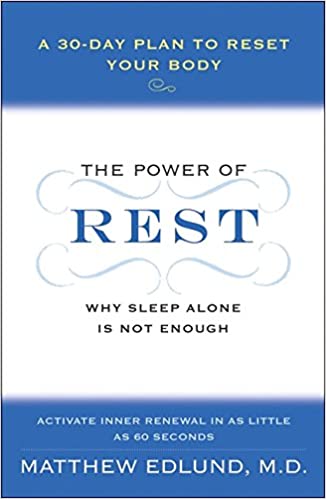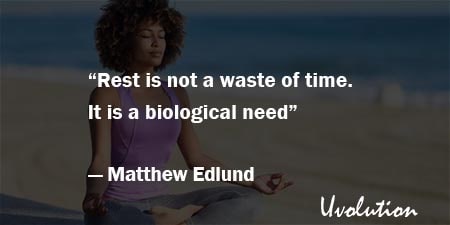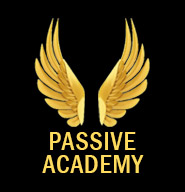The Power of Rest by Dr. Matthew Edlund Summary
The Book in 1 Sentences
The Power of Rest: Why Sleep Alone Is Not Enough. A 30-Day Plan to Reset Your Body
“Rest is powerful. Effective rest can help you succeed by making you alert, whole, productive, and happy. It can also provide meaning, making you and your life both more interesting and more complex.
With this book, you can learn the rudiments of rest, techniques that you can take with you anywhere. With a little practice, you can then apply these techniques to work, love, leisure, and spirit.
It’s time to learn how to rest, to build inner and external strength, to feel healthy and alive, to obtain greater control of your life and consciousness, to get more time to do what you really want to do—and to do more with less.” ~ Matthew Edlund
10 BIG Ideas
1. Rest is NOT a Waste of Time
3. More TV = Risk of Depression
6. Meditation = #1 Active Mental Rest Technique
7. Pray for 1 Minute = #1 Way to Rest Spiritually
The Power of Rest Book Summary
1. Rest is NOT a Waste of Time
“I used to think rest was a waste of time. I’m a doctor—why rest when you can be seeing patients, teaching, and writing research papers? It took me a long time to figure out that most medical people and far more of the general public have gotten the basic facts wrong.
Rest is not a waste of time. It is a biological need—a process for restoration and rebuilding. Rest is not useless but a major pathway to our renewal, our survival. The process of aging need not mean the inevitable decline of a youthful healthy human machine into a rusting, decayed hulk.
Rather, we should see aging as a script in which the body experiences, learns, rebuilds, and regrows (including our brains) throughout our lives. We re-create, renew, and reorganize
ourselves through the process of rest.”
“Ask yourself this: if you could do less and become healthier, more productive, and successful, would you do it? You can, if you know how to rest.”
“Life should be rhythmic and musical. There should be time for activity and rest, for work and relationships.”
2. Circadian Rhythms
“Scientists at Colorado State University studying human genes reported in 2008 that about 98 percent or more of our genes operate according to twenty-four-hour patterns. Life is timed, and sleep, like other forms of rest, also follows circadian rhythms. Circadian rhythms powerfully affect our behavior and our performance.”
Dr. James Maas -in his great book Power Sleep- says: “It’s important to keep your biological clock in absolute synchrony with your daily routine.
In this way the hours you spend in bed will correspond with the sleepy phase of your circadian rhythm and the hours you spend out of bed will correspond with the awake phase of your circadian rhythm.
The only way to do this is to maintain a regular sleep schedule, going to bed at the same time every night and waking up at the same time every day, seven days a week.”
3. More TV = Risk of Depression
“A study done at the University of Pittsburgh and Harvard in 2009 showed that the more TV teenagers watched, the greater their risk of depression during the next seven years.
More TV also generally means less sleep, and less sleep means worse cognitive function and lower grades.
Among adults, late-night TV use is a prominent feature in insomniacs, many of whom eventually become depressed. Another unfortunate biological effect of TV comes from the light emitted by the TV itself.
While morning light sets our internal clocks earlier, light in the evening sets our biological clocks later. Television sets put out a lot of light. The effect in many people is to make them stay up later, cutting down on their sleep time and making it harder for them to wake up in the morning.”
4. 4 kinds of Active Rest
“Active rest is conscious. Active rest is under your control. Active rest is goal oriented and directed. With the techniques of active rest you are about to learn (and there are many more), you will rest your body and mind at will, at your leisure—and for your pleasure.
Doing active rest you will be learning the whole time, restoring your body and developing parts of your brain that will make future techniques of rest easier to learn and use.”
Dr. Edlund describes four kinds of active rest.
Mental Rest + Social Rest + Spiritual Rest + Physical Rest.
“Mental rest means focusing intelligently on your environment in a way that’s rejuvenating. Techniques of mental rest give you the ability to obtain calm and relaxed concentration quickly and effectively and to become relaxed and focused anytime and anywhere. Mental rest allows for greater concentration, awareness, and achievement.
Social rest means using the power of social connectedness to relax and rejuvenate.
Spiritual rest is the practice of connecting with things larger and greater than ourselves, which provides fellowship and meaning in life—factors people hunger for like food.
Physical rest, by focusing your body and its simplest physiological processes, provokes calm, relaxation, mental alertness, and surprisingly better health.”
5. Naps Restore You
“Naps restore you. Even a six-minute nap can improve memory and problem solving. Naps can act as the ideal pick-me-up in the middle of the afternoon or while at work.
Winston Churchill always tried to take a daytime nap. Many world leaders take “power naps.” Before the industrial revolution, most of the population routinely took naps. Why? Human beings are built that way.
Sara Mednick -in her book Take a Nap, Change Your Life!- also tells us: “Let’s look at the rest of the animal kingdom. Do any other species try to get all their sleep in one long stretch? No. They’re all multiphasic, meaning that they have many phases of sleep.
Homo sapiens (our modern industrialized variety, anyway) stand alone in attempting to satisfy the need for sleep in one phase. And even that distinction is a relatively recent development.
For most of our history, a rest during the day was considered as necessary a component of human existence as sleeping at night. As A. Roger Ekirch, one of the few historians to study sleep, put it, ‘Napping is a tool as old as time itself.’”
Dr. Edlund says: “Viewing naps as silly, lazy, and wasteful is shortsighted. Quick, programmed naps can make people feel rested and mentally sharp, improve learning and memory, and if performed in the early afternoon, increase work productivity.”
“Research at Harvard has shown that short periods of daytime sleep—even as short as a six-minute nap—can improve memory.”
“Napping, as you can tell, is controversial. It should not be. Napping is a normal part of human design.”
6. Meditation = #1 Active Mental Rest Technique
“Muscles change with use. Just like everything else. That includes the brain. If you use parts of the brain long enough and repetitively enough, they get bigger. Brain activity leads to anatomic changes...
Long-term meditators grow bigger, fatter frontal lobes. Frontal lobes are where we concentrate, fix our attention, plan, focus, and do much of our analysis of problems. Even novice meditators grow bigger frontal lobes, with fatter sections of gray matter.
One study done by Andrew Newberg of the University of Pennsylvania, who studies the effects of religious practices on the brain, showed that poor recall could be improved by meditation training.”
“Meditators grow their brain. You can’t see the change without MRI scans, of course, but different parts of meditators’ brains grow larger.”
7. Pray for 1 Minute = #1 Way to Rest Spiritually
“Just pray for one minute. Pray as you are, and pray as you hope to be. And when you are finished praying, think about yourself. Is your body calm and feeling at rest? Are you feeling a little more hopeful, just a slight bit more joyous? Do you feel that you have connected a little more with others—others who may sense the same needs for the world that you do?
Regardless of the outcome, pray. The way our bodies and brains are designed and configured, the act itself may prove enough. Prayer and the attempt at spiritual connection are also forms of giving. In that way they are their own reward.”
“In a world that bombards us with information, the art of selective attention becomes increasingly important. That means that self-hypnosis is a skill you’ll want to add to your toolkit.”
8. 5 Breaths = Actively Physically Rest
“Five breaths may not seem like a lot, but it is. With those five breaths you’ve opened up the base of your lungs to better circulation, relaxed your body, concentrated your focus on what your body does in ways that let you both appreciate it and enjoy it, and found a way to rest that literally takes seconds and can be used virtually anywhere and anytime.”
“Breathing, like most forms of physical rest, improves as you practice. It takes a little time. But it’s a technique you’ll be able to do for the rest of your life, so it’s worthwhile getting good at it now.”
“We want to learn to rest anywhere, anytime, in ways that restore us, calm us, relax us, and make us alert. That means we have to learn how to breathe.”
Kelly McGonigal - in his great book The Willpower Instinct- also tells us: “You won’t find many quick fixes in this book, but there is one way to immediately boost willpower: Slow your breathing down to four to six breaths per minute.
That’s ten to fifteen seconds per breath—slower than you normally breathe, but not difficult with a little bit of practice and patience.
Slowing the breath down activates the prefrontal cortex and increases heart rate variability, which helps shift the brain and body from a state of stress to self-control mode. A few minutes of this technique will make you feel calm, in control, and capable of handling cravings or challenges.”
9. Social Rest
“Social rest is powerful. Social rest increases social connections, which can prevent heart attacks, strokes, and perhaps cancer; promote survival; provide personal meaning; and become simple, outrageous fun that will be remembered for a lifetime.
There are many, many techniques of social rest, but many involve social touch, the ability to engage in conversation with someone you know well or want to get to know better. In this chapter you learned how to:
• make a special connection with someone you care about
• visit a neighbor or coworker you’d like to know better
• make quick, useful social connections
• walk with a coworker to lunch
• invite a friend to walk and converse with you in a park
• use sex as social rest.”
Dr Edlund says: “When Freud was asked what the two most important things in life were, he gave a succinct answer: love and work. I think he was right.”
10. We Need BOTH Passive + Active Rest
“In order to live well, we need to rest. We need passive forms of rest, like sleep. We need the time to rebuild our cells and organs.
And we need the active rest techniques you’ve learned in this book because they will make us more alert and more effective. Rest more, accomplish more. Rest well, and you give yourself a better chance to live healthier and longer. So recognize that rest is a priority.”
“Rest is restoration. Without rest, our cells do not reconfigure and regrow, rebuild, and regenerate themselves.”
That was my QUICK summary of the great book The Power of Rest by Dr. Matthew Edlund. If you’re interested, get your copy. There is a HUGE amount of life-changing ideas in this book, and we’ve only touched on a tiny bit of it.
Buy The Book: The Power of Rest by Dr. Matthew Edlund

GET Blinkist 7 Days FREE Trial
3000+ Book Summaries
(Audio and Text)








